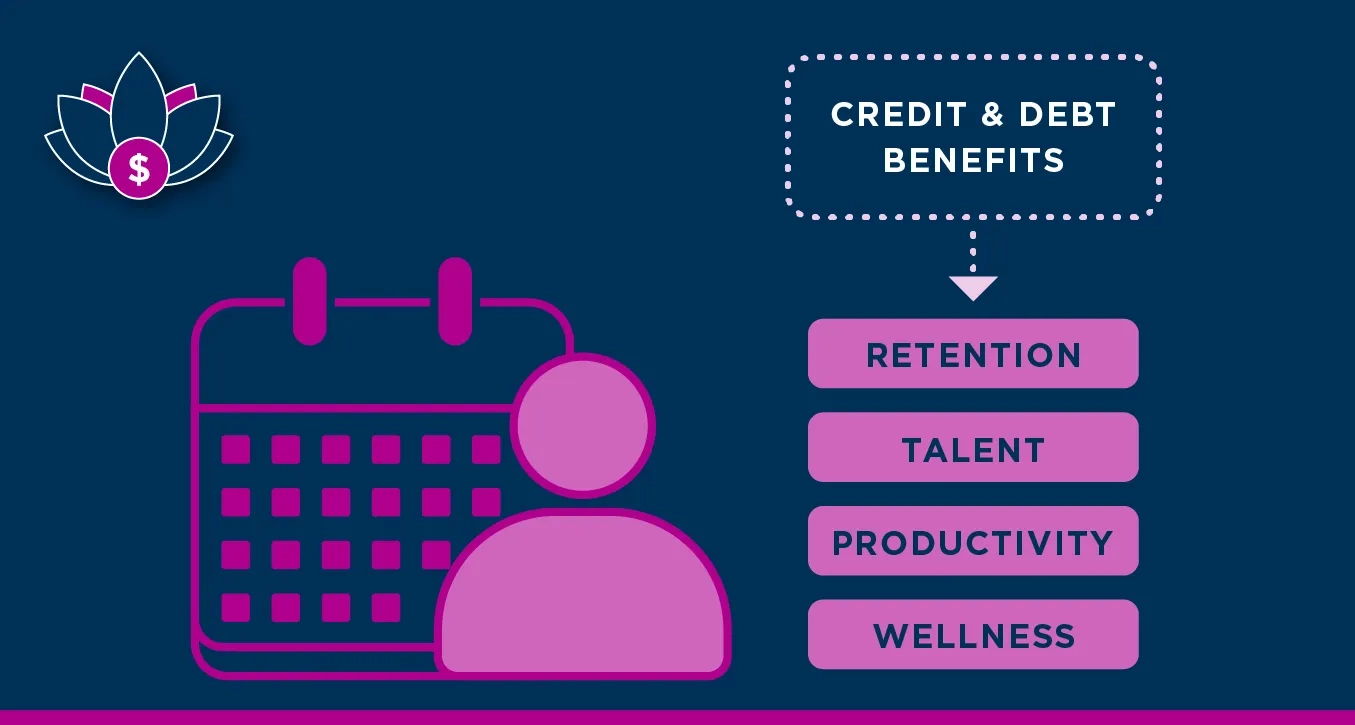Strengthening your credit and debt benefits can help boost their health and productivity, alongside your recruiting, retention, profits, and impact. Here are four things to consider.

“It feels like the holiday debt hangover could be particularly nasty this year,” says Bankrate analyst Ted Rossman per Reuters, citing among other things the growing use of Buy Now, Pay Later loans, with rates that can top out at 36%—the maximum lenders can charge in many states.
Roughly one in three U.S. shoppers went into debt this holiday season, according to a December survey from LendingTree, with 65% of them saying they weren’t planning on it.
Financial stress weighs on employee health, productivity
Financial stress, especially from unexpected expenses, can significantly impact your employees’ physical and emotional health, which then translates into harmful impacts for your organization like absenteeism and reduced productivity: “Effects may include increased irritability, mood swings, appetite changes and stomach issues, fatigue, and/or insomnia. If left unchecked, these symptoms can get worse and may lead to mental health concerns like anxiety, depression, or even suicide.”
Given the workplace effects of financial stress, it’s in every employer’s interest to support your employees in creating debt reduction strategies as part of a holistic financial wellness solution and human capital strategic plan.
When your employees are struggling with debt, finding a flexible financial wellness solution that incorporates debt management programs is important for their (and your organization’s) long-term success.
Debt management programs can help
Debt management programs help borrowers work with their creditors to agree on a debt management plan that is affordable for the borrower and to be paid off within a timeframe acceptable to the creditor. (TrustPlus regularly helps clients work with creditors to reduce and eliminate debt). Debt management programs will become a lot more common in 2024 if current trends continue:
Total household debt increased by $228 billion (1.3%) in the third quarter of 2023, to $17.29 trillion, a new record, according to the Federal Reserve Bank of New York’s Quarterly Report on Household Debt and Credit.
More troubling, delinquency rates for credit cards and car loans are at their highest since 2011 and 2013, respectively, and these rates don’t even include the unexpected debt accrued during the 2023 holiday shopping season.
The bottom line is that many of your employees are stressed about their finances, with holiday debt but the latest factor contributing to their stress.
Personal financial coaching key to impact
By introducing credit and debt benefits that include personal financial coaching—because we know do-it-yourself financial literacy resources alone don’t work—employers can support the financial health and productivity of your employees throughout the holiday debt hangover period and beyond.
Credit and debt benefits typically fall into four categories, debt reduction and consolidation, short-term liquidity, asset building support, and financial guidance.
We provide below an overview of the categories and of four considerations for employers to keep in mind, according to the Financial Health Network, as you consider how to strengthen your debt and credit benefits.
Categories of debt and credit benefits
Debt Reduction and Consolidation
- Access to debt consolidation loans and other forms of debt relief
- Access to student loan solutions that offer evaluation tools and options for reducing payments
- Employer contributions toward student loan repayment
Short-Term Liquidity
- Access to low-cost personal loans that employees pay back via payroll
- Emergency grants to help with unforeseen catastrophic events or illnesses
- Access to an emergency savings account
- Employer contributions to an emergency savings account
- Free or low-cost access to accrued, earned wages in advance of payday
Asset-Building Support
- Access to credit-building products and services
- Access to mortgage loan support
- Access to home buyer/homeowner education and counseling
Financial Guidance
- Free access to financial planning app/website (e.g., budgeting, savings tools and calculators)
- Free credit counseling session to help manage debt
- Free financial education resources
- Free personalized coaching sessions with a financial professional (ahem!)
Debt and credit benefit considerations
Keep equity front and center
Employees with high levels of debt and low incomes are less likely to have access to employer-offered debt-related benefits.
Ensure clear communication, confidentiality, and ease of access
Nearly half of employees (42%) say they’re not adequately informed about the financial wellness benefits their employer offers. Ease of access, confidentiality, and availability of personalized help are challenges to uptake (that TrustPlus is designed to overcome).
Minimize costs to employees
The brief includes examples of fee structures and costs for benefits including financial planning and counseling services, emergency grant funds, and personal loans paid back via payroll.
Your HR and payroll solutions partners can be a useful resource, particularly when it comes to implementing emergency savings and student loan matching programs that are possible as of January 1, 2024, under Secure 2.0.
Ask them what they offer and how they’re working with other organizations. HR payroll solutions companies are an often under-tapped resource here.
Make sure 2024 is the year you draw on all of your available resources in support of the financial health of your workforce.
Regulatory considerations
Contributions from employers and employees to emergency grant funds and student loan repayments can be tax-deductible. Whether you outsource HR and payroll solutions or handle everything in house, explore how Secure 2.0 makes it easier to support your employees in saving for retirement, building emergency savings, and paying off student loan debt.
“Even as employers are expanding their financial wellness offerings, credit- and debt-related benefits remain some of the least frequently offered benefits,” the FHN brief notes. Not for long, as smart businesses in 2024 increasingly understand the benefits of solving for the holiday debt and stress of your employees.






